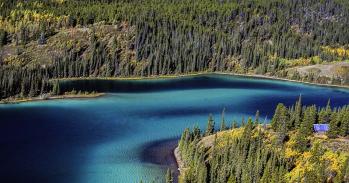
Rumours of trees ‘invading’ the Arctic as a by-product of climate change have been ‘greatly exaggerated’ according to a polar scientist due to lecture on the subject at Cambridge University’s annual Science Festival.
Rumours of trees ‘invading’ the Arctic as a by-product of climate change have been ‘greatly exaggerated’ according to a polar scientist due to lecture on the subject at Cambridge University’s annual Science Festival.
What we are saying is that when you take the step from a climate model to a vegetation model, we may be doing that in a way that exaggerates what is actually happening.
Gareth Rees
Dr Gareth Rees, Researcher at the University’s Scott Polar Research Institute, is speaking at the UK’s biggest free science festival on March 17, using his lecture to talk about the Arctic tree line – and questioning the reliability of vegetation predictions. He will suggest that the relationship between climate warming and tree growth is not as simple as initially thought.
Over the last century, the Earth’s surface temperature increased by about 0.7ºC on average, but global warming is thought to be greater than the average at high latitudes such as in the Arctic.
Climate models predict that the warming trend will continue and that it will be greater in the Arctic. If the forest keeps in step with the changing climate, trees should be advancing northwards at a rate of around 2km a year.
He said: “To generalise our results, the tree line is definitely moving north on average but we do not see any evidence for rates as big as 2km per year anywhere along the Arctic rim.
“Where we have the most detailed information, our results suggest that a rate of around 100 metres per year is more realistic. In some places, the tree line is actually moving south. The prediction of a loss of 40% of the tundra by the end of the century is probably far too alarming.”
Trees are prevented from growing in certain areas because of climatic limitations. Scientists believe that the transition zone from continuous boreal forest to tundra – known as the tree line – will respond to warmer temperatures by moving northwards.
Dr Rees assists in coordinating a group of experts, led by Prof Annika Hofgaard in Norway, who are beginning to question the extent to which the vegetation predictions are borne out in reality. He and his team have been looking primarily at the Arctic rim in Northern Europe, but there are other projects being carried out in Canada, Alaska, northern Scandinavia, Russia and Siberia.
He added: “What we are saying is that when you take the step from a climate model to a vegetation model, we may be doing that in a way that exaggerates what is actually happening. Furthermore, the response around the Arctic rim is by no means uniform. In some places along the Arctic rim the tree line is actually moving south.”
In addition to a suitable climate, there are many conditions necessary for the growth of trees such as the production of viable seeds, the absence of animals that destroy saplings and the presence of suitable soil. In some places, there is quite significant pressure holding back the advance of forests.
These findings are very important because they affect the global climate system. Forested land has a much different impact on the earth’s climate than flat ground in two ways.
Firstly, trees transpire much more water than smaller plants. This has a serious effect on the hydrological cycle. Scientists who develop models for the earth’s climate system need to know how water is being moved around in the global system.
Secondly, the increase of tree growth will accelerate warming trends that are already occurring. Trees help to increase the temperature of the climate system because they are very dark and absorb sunlight.
The vegetation to climate feedback is very important for scientists to understand how the global climate works and make climatic models. The climate dictates where vegetation can grow yet vegetation can change the climate.
Dr Rees concluded: “We understand a bit about what’s going on but definitely not enough.”
Dr Rees will be giving his talk Are trees invading the Arctic?on the movement of forest in the Arctic at the Cambridge Science Festival on March 17, 1.30pm-2.30pm at the Scott Polar Research Institute. It is free and suitable for ages ten plus. There will also be a chance to meet polar scientists and try some hands-on science, including tree hugging (a genuine way to estimate the height and age of a tree) and learning how to estimate the climatic value of a tree, in the ‘science on ice’ outdoor activities taking place at the Scott Polar Research between 10.30am-3pm.
To pre book call 01223 336540 or email enquiries@spri.cam.ac.uk. For further details please visit www.cam.ac.uk/sciencefestival.
This work is licensed under a Creative Commons Licence. If you use this content on your site please link back to this page.





